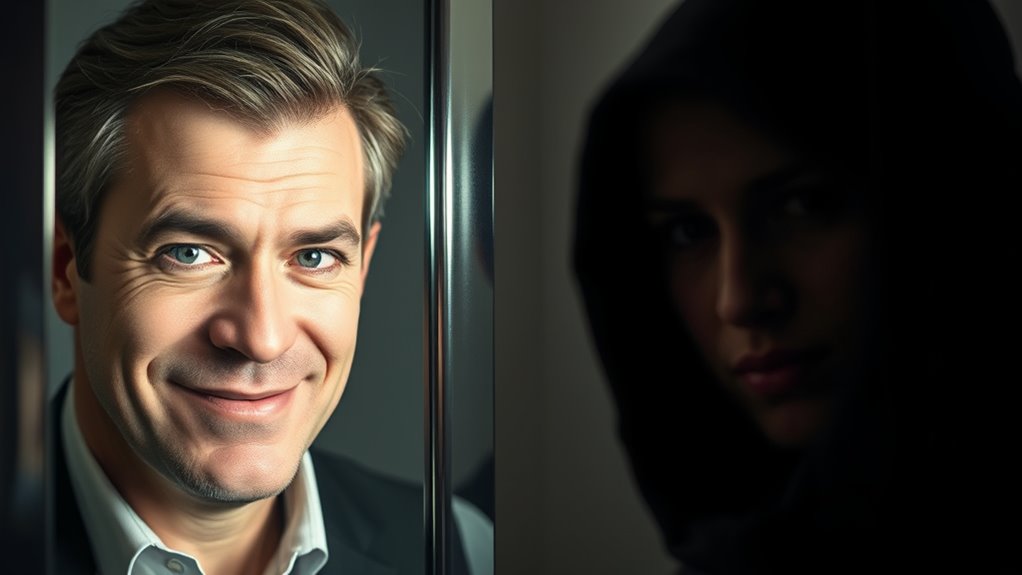Overt narcissists are openly boastful, confident, and seek constant attention, often reacting with anger or aggression when challenged. In contrast, covert narcissists appear reserved and modest but secretly hold a grandiose self-view, responding to criticism with withdrawal or passive-aggression. They manipulate subtly rather than seek the spotlight directly. Recognizing these differences helps you understand their social behaviors and emotional reactions better — continue to explore these distinctions to uncover what drives their behaviors more deeply.
Key Takeaways
- Overt narcissists are extroverted, boastful, and seek admiration, while covert narcissists are introverted, reserved, and mask their grandiosity with vulnerability.
- Overt types display loud, aggressive reactions to criticism; covert types respond with withdrawal, passive-aggression, or emotional hurt.
- Overt narcissists dominate social settings openly, whereas covert narcissists influence subtly through emotional manipulation and passive tactics.
- Overt narcissists see themselves as superior and seek external validation; covert narcissists have fragile self-esteem and rely on subtle self-pity.
- Overt narcissists react confrontationally to threats, while covert narcissists tend to internalize stress and react emotionally in less obvious ways.
External Presentation and Behavior

When comparing overt and covert narcissists, their external presentation and behavior reveal key differences. Overt narcissists are typically more extroverted, openly seeking attention and admiration. They display grandiosity confidently and aim to craft a grand public image, often appearing charismatic and self-assured. These individuals tend to thrive on external validation and often monopolize conversations to highlight their achievements.
In contrast, covert narcissists tend to be introverted and reserved, avoiding the spotlight. They mask their grandiosity with vulnerability and self-pity, often withdrawing from social interactions. They may also exhibit emotional manipulation, such as guilt-tripping or passive-aggressive behaviors, as subtle tools to gain validation and control over others. Their hidden insecurities often drive their need for validation through indirect means.
While overt narcissists assert their self-importance openly and project strength, covert narcissists do so subtly, using emotional manipulation and feigned empathy. They may appear modest or shy but still harbor a desire for validation, often through indirect means. Recognizing these traits can also aid in understanding how their mindset influences their interactions and self-perception.
Social Interaction Patterns

Overt and covert narcissists exhibit distinct social interaction patterns that reflect their underlying personalities. You’ll notice overt narcissists dominate social scenes, seeking the spotlight through assertiveness and extroverted behavior. They often form shallow connections focused on admiration and personal gain, using aggressive communication and grandiose language to impress others. In contrast, covert narcissists tend to engage more quietly, often under the guise of humility. They may build relationships through emotional manipulation and passive-aggressive tactics, subtly influencing group decisions and using guilt to sway others. Both struggle with maintaining long-term relationships due to their self-centeredness and lack of empathy. In group settings, overt types seek leadership, while covert individuals influence behind the scenes, often indirectly. Additionally, their social interaction patterns can be influenced by their internal personality traits, affecting how they relate to others and navigate social environments. These traits can include tendencies toward narcissistic defenses, which shape their behaviors and responses in social contexts. A deeper understanding of these social behavior differences can help in recognizing their distinct approaches to social engagement. Moreover, awareness of their affiliative strategies can assist in identifying underlying motivations behind their actions.
Emotional Reactions and Management

Emotional reactions and management differ markedly between overt and covert narcissists, shaping how you express and handle your feelings. Overt narcissists tend to display emotions loudly and seek attention, often using anger or aggression to manipulate others. They thrive on public displays of intense emotion, which serve to reinforce their dominance. Aesthetic Wall Organization can sometimes reflect the boldness or confidence seen in overt narcissists, emphasizing their desire for attention. Interestingly, the strong reputation of brands like KTM in electric dirt bikes and their high-performance qualities, such as horsepower and speed, mirror the overt narcissist’s need for recognition and admiration. Furthermore, their tendency to showcase their achievements openly aligns with their craving for validation and admiration. Additionally, understanding financial scams related to investments like Gold IRAs can help protect their reputation and assets from manipulation or fraud.
In contrast, covert narcissists internalize their feelings, experiencing anxiety and depression but suppressing outward signs. They struggle with emotional control, becoming hypersensitive and defensive, especially when criticized. Their heightened sensitivity to criticism and internal turmoil can strain relationships, as their emotional responses are often unpredictable and challenging to manage effectively. This internalized experience makes them more prone to passive-aggressive behaviors, which serve as subtle ways to express their dissatisfaction without open confrontation. They may also resort to self-pity as a way to garner sympathy and attention indirectly, highlighting their internal struggles. Recognizing these behaviors can be crucial in managing interactions and setting healthy boundaries.
Underlying Self-Perception

Underlying self-perception in narcissists shapes how you see yourself and influences your behavior. If you’re an overt narcissist, you likely think highly of your accomplishments and believe you’re entitled to admiration. Your self-worth depends on external validation, so you actively seek attention to reinforce your self-image. You’re confident and assertive, often displaying your superiority openly. In contrast, a covert narcissist perceives themselves as more modest or humble on the surface but still holds a grandiose view internally. You might use self-deprecation or appear insecure, masking your self-importance. Both types believe in a greater sense of self, but overt narcissists are more openly boastful, while covert ones maintain a fragile sense of importance beneath a veneer of humility. Your self-perception deeply shapes your interactions and emotional responses. Additionally, understanding self-esteem maintenance strategies can help distinguish between these narcissistic styles. This internal conflict often manifests in emotional vulnerability, even among those who appear outwardly confident, highlighting how self-awareness impacts emotional resilience. Recognizing these differences can be crucial for developing healthier self-perception and emotional stability. Exploring defense mechanisms further reveals how narcissists protect their fragile self-image from perceived threats.
Response to Criticism and Conflict

When faced with criticism or conflict, narcissists respond in ways that reflect their underlying self-perception. Overt narcissists often react with outrage or anger, showing aggression and denial to defend their sense of superiority. They may lash out or belittle others to maintain their self-image and react immediately and confrontationally. Conversely, covert narcissists tend to withdraw or become passive-aggressive, expressing hurt or victimhood instead of direct confrontation. They might use self-deprecation or sulk silently, hoping to elicit sympathy or deflect blame. Their reactions are subtle and emotional, often rooted in feelings of being misunderstood or undervalued. Additionally, their reactions are influenced by their emotional resilience, which can vary significantly between overt and covert narcissists. While overt narcissists seek admiration openly, covert narcissists manipulate behind the scenes, making their responses to criticism more indirect and emotionally complex. Recognizing these behavioral differences can help in understanding the manipulative tendencies that often accompany narcissistic responses to conflict. Furthermore, differences in coping mechanisms influence how each type processes stress and criticism, impacting their interpersonal dynamics. Moreover, the reaction styles of each type are shaped by their distinct coping mechanisms and self-esteem levels, affecting their interpersonal dynamics.
Frequently Asked Questions
How Do Overt and Covert Narcissists Differ in Their Long-Term Relationships?
In long-term relationships, you’ll notice overt narcissists often create visible conflicts and demand control, leading to instability.
Covert narcissists, however, subtly undermine trust through emotional manipulation, making the relationship feel unstable over time.
You might feel emotionally exhausted with both, but covert narcissists make it harder to recognize the issues, trapping you in a cycle of gradual mistrust, while overt ones cause more obvious confrontations.
Both can be deeply damaging.
Can Covert Narcissists Be More Dangerous Than Overt Narcissists?
You might wonder if covert narcissists pose a greater danger than overt ones. They can be more harmful because their manipulative and passive-aggressive tactics are subtle and harder to detect.
This stealthiness allows them to undermine and control you over time without obvious signs. Their indirect attacks and guilt trips can deeply damage your self-esteem and trust.
Making their long-term impact potentially more destructive than the more obvious aggression of overt narcissists.
Are Covert Narcissists More Likely to Seek Therapy Than Overt Narcissists?
Imagine a hidden storm brewing inside you, prompting you to seek shelter—this is often the case with covert narcissists. You’re more likely to seek therapy because emotional vulnerability and distress push you toward understanding yourself.
Unlike overt narcissists, who wear a mask of grandiosity, your inner world compels you to explore hidden depths, making therapy more accessible and appealing in your journey toward self-awareness.
How Does Childhood Upbringing Influence Overt Versus Covert Narcissism?
Childhood upbringing shapes both overt and covert narcissism differently. If you experienced excessive praise, you’re more likely to develop overt narcissism, feeling grandiose and externally confident.
Conversely, neglect or emotional abuse can lead to covert narcissism, making you passive-aggressive and manipulative.
Your early environment influences how you seek validation and cope with emotional needs, ultimately affecting your adult relationships and behaviors.
Can Someone Exhibit Both Overt and Covert Narcissistic Traits Simultaneously?
You might find it interesting that someone can indeed display a blend of outward confidence and hidden vulnerabilities. This combination often depends on situations and how they seek validation.
You may notice moments of boldness intertwined with feelings of insecurity, revealing a complex personality. Recognizing this coexistence helps you understand that narcissistic traits aren’t always clear-cut, but rather a nuanced interplay of behaviors influenced by internal and external factors.
Conclusion
Understanding the difference between overt and covert narcissism is like seeing two sides of the same coin—you might spot the bold, flashy face or the quiet, hidden depth. Recognizing these traits helps you navigate relationships more wisely, protecting your peace and setting healthy boundaries. Remember, not all narcissists wear their hearts on their sleeves; some hide beneath a calm surface. Stay aware, stay cautious, and trust your instincts to steer clear of emotional pitfalls.










